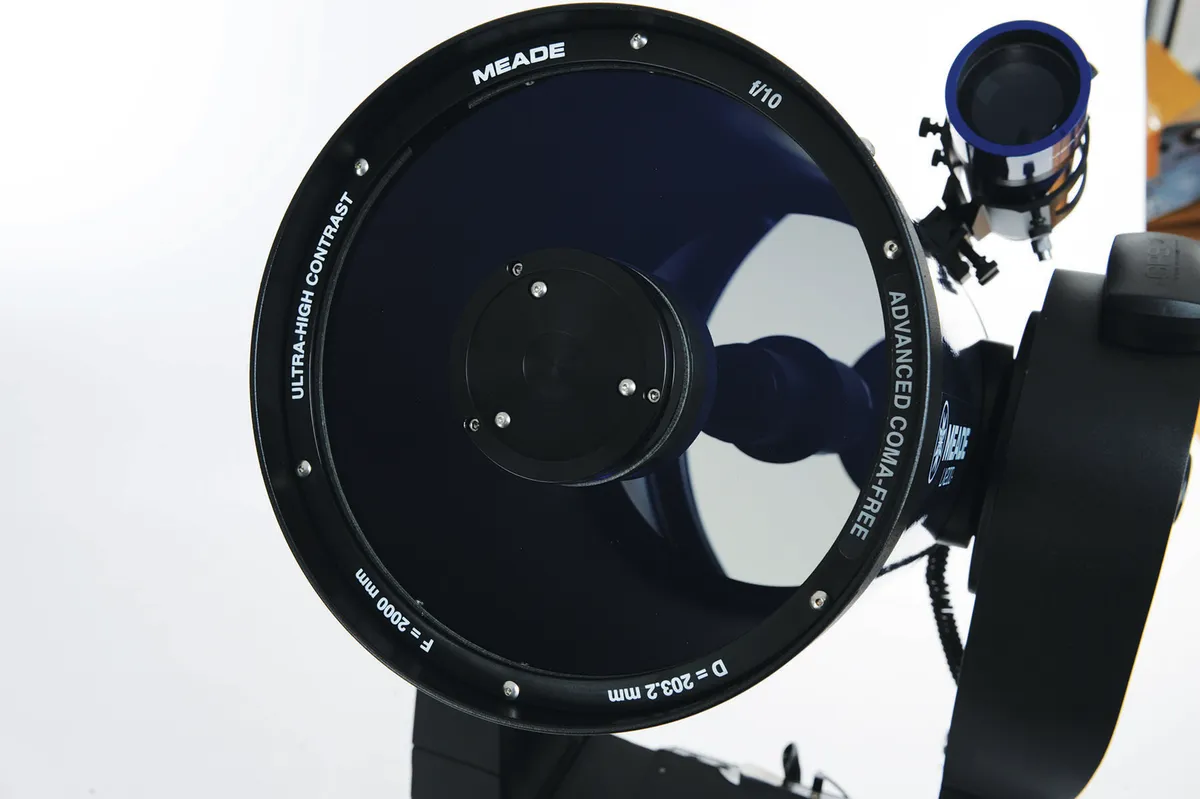Even serious astronomers like having a few bells and whistles to play with and the Meade LX200-ACF telescope certainly packs them in.The LX200 design places the telescope’s tube between two robust forks fixed to a base that houses the telescope’s brain – a sophisticated AutoStar II computer.
Using various positional sensors the scope is able to work out when and where it is in the world using an auto-alignment procedure.
This takes a few minutes to complete; once done, AutoStar asks you to centre a couple of selected bright stars in the eyepiece.If everything’s okay, you’re then all set to access the Universe at the touch of a button.
The LX200-ACF telescope stands out from its predecessors because of its advanced coma-free (ACF) optics.The original LX200 range was based on the Schmidt-Cassegrain telescope, which uses an easy-to-produce spherical primary mirror as its optical heart.
Unfortunately, such mirrors have a flaw because they have spherical aberration, a condition where light from the outer part of the mirror reaches focus closer to the mirror than light from the centre.
A corrector plate is usually fitted to the front of the telescope to reduce the spherical aberration, but the design would still suffer from coma, which causes stars at the edge of the view to look a bit blurred.
Traditionally, scopes that try to correct for both optical aberrations, called aplanatic telescopes, are expensive to produce.
The LX200-ACF design overcomes both problems inexpensively by using a hyperbolic secondary mirror.
This results in a high-performance optical system that delivers pin-sharp stars across the entire field of view.
The AutoStar II’s database contains an impressive 147,541 selectable objects ranging from the Moon right down to some eye-straining faint fuzzies.
Don’t expect to be able to see all of the objects on offer, though, because some are beyond the visual capability of the telescope but would be picked up by a sensitive CCD camera.
Despite an initial glitch, finding objects with the AutoStar’s Go-To function worked very well; it placed them in the field of view of a low-power eyepiece every time.

Optical opulence
Through the eyepiece this scope really delivers; the field of view appears vibrant and bright.
We chose a good range of galaxies, globular clusters, open clusters and nebulae to test the scope and were treated to a number of memorably impressive sights.
Although we used the supplied 26mm Plössl as much as possible, we did augment it with a couple of extra eyepieces of our own for a bit of extra range.
The globular cluster M15 in Pegasus looked fantastic at 100x magnification: a haze of stars, most of them resolved.However, we were really treated at around 400x when the field of view filled up with pinpoint stars from edge to edge.
The scope’s advanced coma-free (ACF) design really does seem to work well.M27, the Dumbbell Nebula, was a joy to see with its hourglass shape easy to make out.
Its smaller cousin M76 was another attractive target and its apple core form was obvious.
The difficult face-on spiral galaxy M74 in Pisces had definite structure to its core and the mottled patches in its spiral arms were a wonderful sight.
With ultra-high transmission coatings, the optics certainly deliver some excellent high-contrast views.
Although Solar System objects were a bit thin on the ground during the time of our test, we did manage to get a look at Uranus.Using the supplied eyepiece, the planet showed a beautiful pale green disc, like a distant emerald.
At 400x it took on a 3D appearance with the edges of the planet looking slightly dimmer than the centre.
If we’re honest, the only thing wrong with the 8-inch LX200 is what’s not included.
To start with, hex collimation bolts in the centre of the corrector plate could be replaced with collimation thumb screws; fumbling about with a metal hex key in the dark, close to the corrector plate, is a risky business so close to the optics.
An inexpensive flexible dew shield would be a welcome extra too, especially considering what the damp UK nights are like.
Then there’s the LX200’s design itself. While capable of delivering some great visuals, imagers are going to have to spend more money to get the most out of it because the supplied altaz mount causes a camera’s field of view to rotate during an exposure.
The options to remove this effect are to use a field de-rotator, a Meade DSI Pro camera that can de-rotate short images, or fit the scope on a polar-aligned wedge.
As long as you’re aware of this issue or simply want to use the scope for observing, the 8-inch LX200-ACF is a great performer and the perfect upgrade for a beginner wanting to move on to something more serious.

Vital stats
- Price£2649.99
- Aperture8 inches (203mm)
- Focal Length2,000mm (f/10)
- MountLX200 AutoStar II computerised altaz with Go-To
- Weight33kg (73lbs)
- SupplierTelescope House
- Telephone01892 550100
- Websitewww.telescopehouse.com
This article appeared in the November 2008 issue of Sky at Night Magazine
